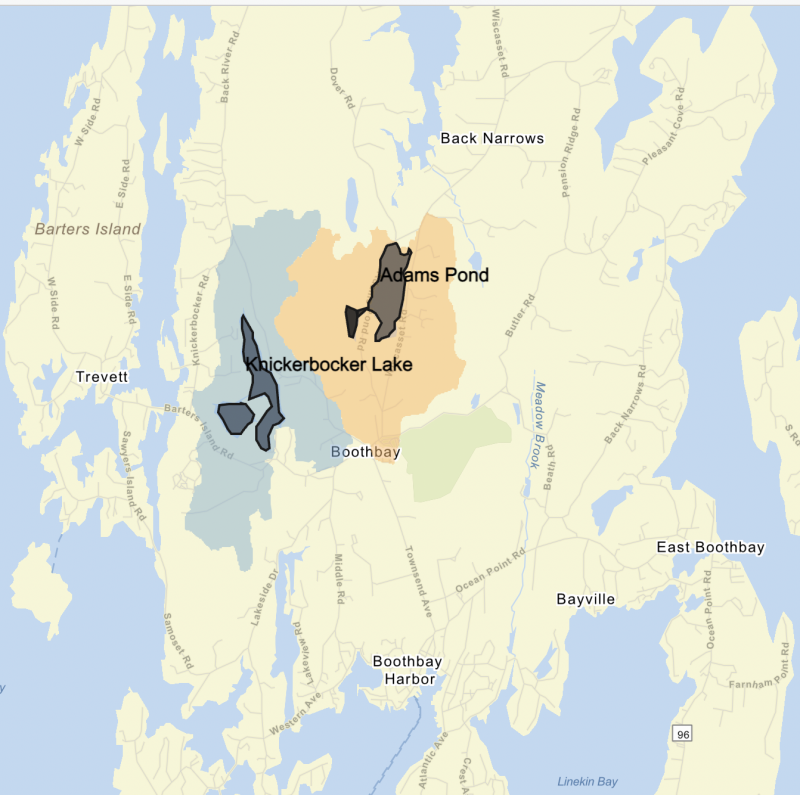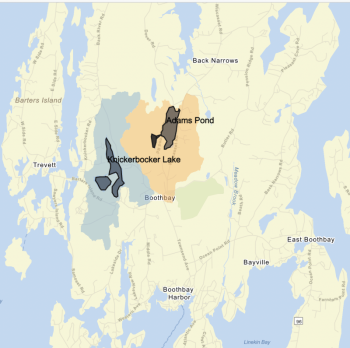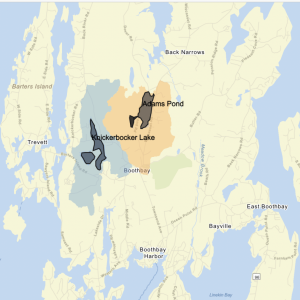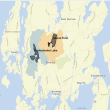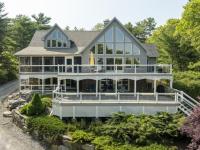Safeguarding Boothbay peninsula’s drinking water
Do you ever think about where your drinking water comes from, or the quality of your water? You likely don’t give it a second thought as long as water pours from the tap when you turn it on. Unless you have a well, your home’s drinking water comes from the only sources of public drinking water on the Boothbay peninsula – Adams Pond and Knickerbocker Lake. Even if your household is not connected to the public water supply, most of the businesses, public institutions, and services you rely on are. Unfortunately, few know that for many years these lakes have been categorized as “threatened” by Maine’s Department of Environmental Protection due to pollution from the developed land in their watershed.
A watershed is all the land that drains both surface and groundwater to a waterbody. While rain does fall directly on the lakes, most of the water replenishing our public water supply lakes comes from their watersheds. More than one billion gallons of water flow into Adams Pond and Knickerbocker Lake from their watersheds every year.
The water that flows into the lakes from the watershed is essential to maintaining the quantity of water in our lakes. The watersheds are also the primary determinant of water quality. Forested areas of the watersheds are better able to slow down and capture storm water, filter out contaminants and recharge the aquifer. In the developed portions of the watershed, runoff and erosion from hard surfaces, as well as contaminants associated with septic systems, motor vehicles, pesticides, and fertilizers are carried downstream to the lakes.
Studies have shown both here and elsewhere that developed watershed properties contribute a disproportionate pollutant load to lakes when compared to undeveloped areas. For example, while just 7% of the Knickerbocker Lake watershed is developed, that developed land produces 57% of the phosphorous pollutant load to Knickerbocker Lake.
Statistics like these make clear, our lakes and their watersheds are inseparable. They act together as one integrated water system. We know our public water supply lakes will be healthier and better able to support the community if their watersheds are protected from development. Without an adequate supply of clean drinking water, economic development in the Boothbay Region will be severely constrained. Luckily for us, most of the land within the Adams Pond and Knickerbocker Lake watersheds remains undeveloped.
This matchless opportunity to safeguard forever the quality of our drinking water is why a diverse group of our community non-profit organizations have joined with the towns of Boothbay, Boothbay Harbor and Southport to form an initiative to conserve the undeveloped land remaining in the watershed. The name of this new group is the Boothbay Region Clean Drinking Water Initiative, and its members are Bigelow Laboratories for Ocean Sciences, Boothbay Region Land Trust, Boothbay Region Water District, Boothbay Region YMCA, Coastal Maine Botanical Gardens, Knickerbocker Lake Association, and the towns of Boothbay, Boothbay Harbor and Southport.
The new Initiative’s mission statement is “To forever safeguard the Boothbay Region public drinking water supply through land conservation, education, stewardship and community collaboration.”
Over the coming months, we will host small gatherings so anyone interested can learn more about this initiative, its goals, our public water supply and its watersheds. We want to share information, hear from the community and address your concerns, questions and interests.

